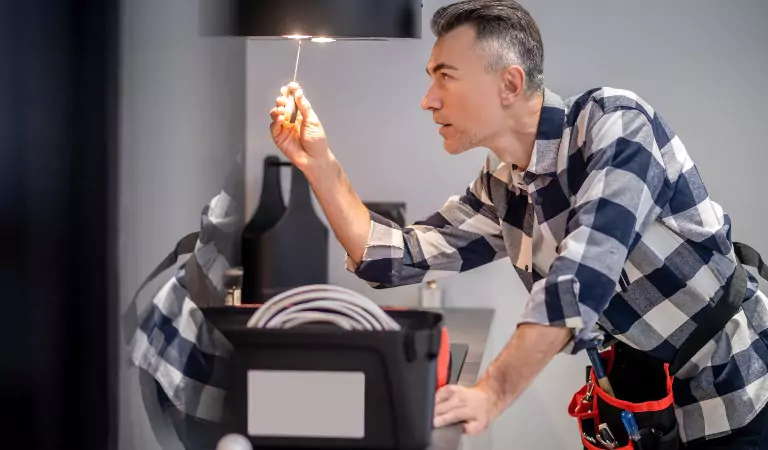

Lighting does more than just brighten up a room; it sets the mood, adds comfort, and changes how your home feels. The right lighting can make a small space look bigger, create a cosy atmosphere in your living room, or add elegance to your dining area. It also plays a practical role by making tasks like cooking, reading, or working easier and safer.
However, with so many options available, selecting the appropriate lighting can be difficult. Should you pick the warm or cold tones? Ceiling downlights or statement pendants? LEDs or halogens? To help you in making the proper decision, here is a simple guide to selecting the ideal lighting for every room in your home. Also, knowing when to engage a professional electrician in Australia for safe and skilled installation can also help you save time, stress and potential hazards.
Every room in your home has a different purpose, and so should the lighting. Bedrooms, for example, demand a calm and restful environment, whilst your kitchen or study space requires brighter and clearer lighting to complete work.
To highlight artworks or bookshelves in a living space; combine ambient lighting with accent lighting. Kitchens require task lighting above the counters and sinks to enable safe, and efficient cooking. Bathrooms benefit from strong vanity lighting that eliminates shadows on your face. For these focused installations; engaging an electrician in Australia ensures that fittings are securely wired and positioned in appropriate locations.
Before going to the store, learn about the three types of lighting: ambient, task, and accent. Ambient lighting is your primary light source, brightening the environment evenly. Task lighting, as the name implies, concentrates on certain tasks such as reading, cooking, and working.
Accent lighting enhances character by spotlighting paintings, architectural details or textured walls. Combining them produces a balanced and layered feel that makes your home appear professionally designed. Experimenting with different combinations also allows you to determine what best matches your lifestyle, making sure that your area is both functional and visually appealing.
Light bulbs come in different colour temperatures, measured in Kelvin (K). Warm white (2700 to 3000K) creates a soft and cosy feel, perfect for bedrooms and lounges. Cool white (4000K) and daylight (5000K to 6500K) are brighter and clearer, suitable for kitchens, studies, and bathrooms where visibility is crucial.
Additionally, pay attention to lumens, which indicate how bright the bulb will be. A higher lumen indicates a brighter light. Before making a purchase, check both lumens and Kelvin to ensure you obtain the desired atmosphere. If you're not sure how to balance temperatures and brightness in your rooms, an experienced electrician in Australia can help during your remodel or build.
With growing electricity bills, using energy efficient lighting saves money in the long run. LED bulbs consume up to 75% less energy, than standard incandescent bulbs and last far longer. They also produce less heat which makes them appropriate for enclosed spaces or tiny rooms.
Here’s why you should prioritise energy efficient lighting:
While LED bulbs are slightly more expensive, their longevity and efficiency balance the expense over time. Furthermore, adopting smart lighting solutions allows you to remotely turn off overlooked lights, resulting in significant cost savings.
Lighting serves as decoration. Statement chandeliers in dining rooms, elegant pendant lights above kitchen islands, and eye catching floor lamps in reading areas all add personality to your space. Consider your home's theme: minimalist, industrial, vintage or contemporary to ensure everything blends together smoothly.
Always keep the scale in mind. A big chandelier in a small room can be overbearing, whereas a tiny pendant in a large hall may appear lost. Experimenting with textures, forms, and finishes adds depth and fascination to your interiors. If you're installing several decorative lights, use a professional electrician in Australia to ensure proper placement, electrical safety, and flawless execution.
If you are building or renovating; plan your lighting layout during the design stage itself. Deciding where each fitting, switchboard and power outlet will go makes the installation process smoother and saves you from expensive reworks later.
Discuss your plans with your architect, interior designer, and electrician to create a lighting scheme that complements your furniture placement and wall colours. Early planning also makes sure that concealed lights, dimmers or false ceiling lights are included in the budget, and structural design seamlessly.
Choosing the appropriate lighting for your house means blending functionality and aesthetics to create rooms that are inviting, efficient and stylish. Understanding bulb temps, combining lighting types, and planning layouts ahead of time can have a huge impact on how your home appears and feels. If you are ever confused, contact a qualified electrician in Australia. Their experience ensures that your lighting is placed safely and performs properly, giving your home the glow it deserves.
 7 Essential Electrical Tips for Home Solar Power Installation
02 Jun, 2025
7 Essential Electrical Tips for Home Solar Power Installation
02 Jun, 2025
 How Often Should You Check And Replace Fire Alarms?
06 May, 2025
How Often Should You Check And Replace Fire Alarms?
06 May, 2025
 Installing an EV Charger at Home: What You Need to Know
03 Mar, 2025
Installing an EV Charger at Home: What You Need to Know
03 Mar, 2025
 Understanding Circuit Breakers: What Homeowners Need To Know
15 Jan, 2025
Understanding Circuit Breakers: What Homeowners Need To Know
15 Jan, 2025
 Childproof Your Home: 7 Key Electrical Safety Tips
27 Dec, 2024
Childproof Your Home: 7 Key Electrical Safety Tips
27 Dec, 2024